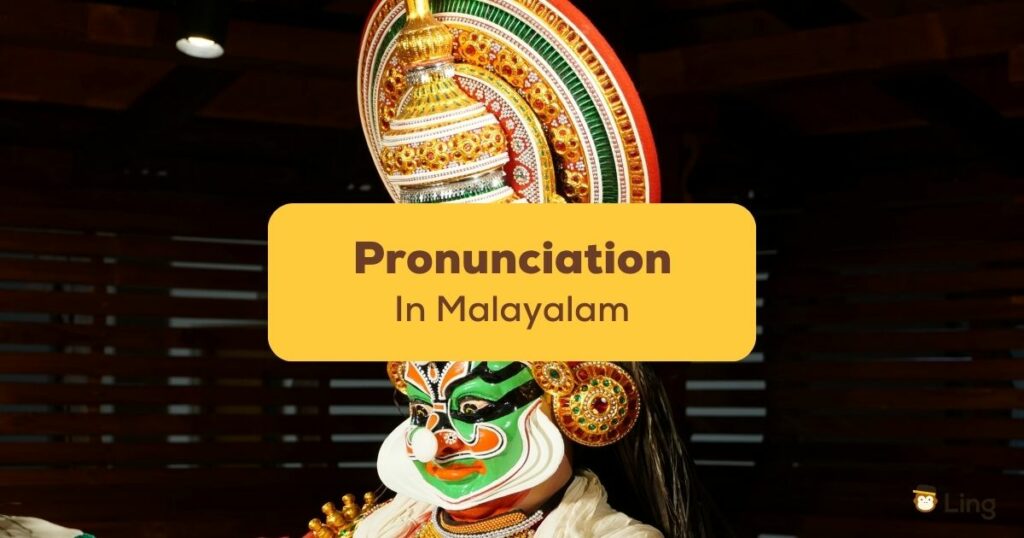Have you ever heard someone speak Malayalam and wondered if they were casting a spell or telling an old tale? Did their language sound so unique and unfamiliar that it seemed like an impenetrable code? Well, fear not! In this article, we’re going to unravel the mysteries of Malayalam pronunciation and make it as easy as munching on a banana fritter!
Now, let’s be honest here. For those of us hailing from the Western world, mastering the art of Malayalam pronunciation can be a bit tricky. It’s not exactly a walk in the park. You see, Malayalam, the language spoken in the southwestern state of Kerala in India, belongs to the Dravidian language family. Therefore, it has its own unique set of phonetics and sounds that can leave even the most linguistically inclined scratching their heads.
But here’s the good news. If you happen to come from a linguistic background that shares some similarities with Malayalam, such as Tamil or other Dravidian languages, you might just have a head start! For the rest of us, fear not; with a little practice and a pinch of humor, we’ll have you pronouncing Malayalam like a native in no time.
In this article, we’ll embark on an adventurous journey through the linguistic landscape of Malayalam pronunciation. We’ll tackle those tricky consonant clusters that seem to defy logic, like trying to tie a knot with cooked spaghetti. We’ll unravel the mysteries of the elusive retroflex sounds that can leave your tongue in a twist. And we’ll dive headfirst into the rhythmic world of vowel length, where a single extra second of pronunciation can change the entire meaning of a word!
You may be a language enthusiast looking to expand your linguistic repertoire, or simply preparing for a trip to God’s Own Country. Either way, this article will equip you with the tools to pronounce Malayalam with confidence, flair, and a few laughs along the way.

Malayalam Pronunciation Basics
Malayalam is not just any ordinary language; it’s a phonetic and syllabic marvel that will make your tongue do acrobatics you never thought possible. What does this mean? Well, phonetic means that (most of the time) you pronounce it as you write it, and syllabic means you have an alphabet and you make syllables with that alphabet.
Malayalam Script
But let’s start with the script itself. Malayalam is a complex yet beautifully crafted script, characterized by its flowing curves and intricate details. The script possesses a unique charm that captivates the eyes and adds a touch of artistic flair to the written word. It’s a feast for the eyes!
The script is derived from the ancient Brahmi script and belongs to the family of scripts known as the Brahmic scripts, which also include other Indian scripts like Devanagari, Bengali, and Tamil.
The script has a total of 54 characters, including 42 consonants and 12 vowel symbols. The script is written from left to right, and each character is typically represented by a curved or circular shape.

Basic Consonants
Now, hold on to your hat, because we’re about to dive into the marvelous world of alphabetical order in Malayalam. Brace yourself! In this language, they like to keep things interesting. Instead of starting with the consonants like most languages, Malayalam kicks off with a grand entrance by the vowels. Yes, you heard that right! The vowels take center stage and say, “Hey, we’re the stars here!” And only after the vowel extravaganza concludes do the consonants make their appearance. But we’ll talk about vowels later on.
In Malayalam, consonants always come with an inherent “a” sound, like they’re in a never-ending karaoke session. Unless, of course, they decide to rebel and wear a different dependent vowel or get “cut off” with the special crescent sign, leaving them to dance solo without the “a” sound.
Here is a table of the basic consonants in Malayalam script:
| ക | ഖ | ഗ | ഘ | ങ |
| ka | kha | ga | gha | ṅa |
| ച | ഛ | ജ | ഝ | ഞ |
| ca | cha | ja | jha | ña |
| ട | ഠ | ഡ | ഢ | ണ |
| ṭa | ṭha | ḍa | ḍha | ṇa |
| ത | ഥ | ദ | ധ | ന |
| ta | tha | da | dha | na |
| പ | ഫ | ബ | ഭ | മ |
| pa | pha | ba | bha | ma |
| യ | ര | ല | വ | |
| ya | ra | la | va | |
| ശ | ഷ | സ | ഹ | |
| śa | ṣa | sa | ha | |
| ള | ഴ | റ | ||
| ḷa | ḻa | ra |
There is a reason the alphabet is written this way: The pronunciation of each row moves from the back of the mouth to the front. The final three rows have special characters and are, in order, the semivowels, the s-sounds, and the special Tamil sounds. Regarding columns, the pronunciation of the columns starts with “unvoiced” consonants (that do not make the vocal cords vibrate), then “voiced,” then “nasals” or n-sounds.
The ത row may be a bit hard for American English speakers, who often pronounce “ta” sounds towards the back of the mouth. A good trick to master this Malayalam pronunciation is to push the tongue forward and keep it below the front teeth when making these sounds.
For the ട row, point the tip of the tongue towards the top of the head.
Another example is the ശ sound, which is “palatal”: pronounced with the tongue flat against the palate (similar to the ച row). On the other hand, the ഷ sound is “retroflex,” with the tongue pointing to the top of the head (like the ട row).
Finally, the special letter ള is a retroflex l-sound— where your tongue is pointing up. The letter റ is basically a retroflex r-sound, harsher than the letter ര, which is pronounced with the tongue just behind the teeth (alveolar).
Last but not least, we come to the pride of South India, the letter ഴ, unique to the South Indian languages. Simply put, roll your tongue back and try to touch your palate while the air flows through the sides of your tongue. Try to make an r-sound similar to the one on the English word “rate.”

Doubled Consonants
Doubled consonants are something actually very common in Malayalam, where letters from the ക and ങ (nasals) columns are doubled. For example, in എനിക്ക് (enikku – “to me”), കാപ്പി (kaappi – “coffee”) or പത്ത് (pathu – “ten”).
To pronounce these letters, you mostly say them in a harder way, hitting the consonant in a crispier and more precise manner. On the other hand, for nasal sounds, you just linger a little bit longer.
| ക്ക | ഗ്ഗ |
| kka | gga |
| ച്ച | ഞ്ഞ |
| cca | ñña |
| ട്ട | ണ്ണ |
| ṭṭa | ṇṇa |
| ത്ത | ന്ന |
| tta | nna |
| പ്പ | മ്മ |
| ppa | mma |
| യ്യ | |
| yya | |
| ശ്ശ | |
| śśa | |
| ല്ല | |
| lla |
Initial Vowels
Now, here’s the first rule of engagement with the script: When a word begins with a vowel, the initial vowel form is used, giving it a prominent and unique appearance. This initial vowel form is beautifully designed, often featuring elongated and embellished strokes, making it visually appealing. It adds a touch of elegance to the script and enhances the overall aesthetic of the written language.
The use of initial vowel forms in Malayalam script also reflects the respect and importance given to vowels in the language. Vowels are considered the life force of words, providing the essential sounds that shape their meaning and pronunciation.
Here is a table with the initial vowels in Malayalam. This table is written in this way with a reason: the first row is simple vowels, the second row shows the diphthongs, which combine two vowel sounds into one, and the third row is comprised of the special sounds called anusvāra and visarga that come from Sanskrit.
| അ | ആ | ഇ | ഈ | ഉ | ഊ | ഋ |
| a | ā | I | ī | u | ū | ṛ |
| എ | ഏ | ഐ | ഒ | ഓ | ഔ | |
| e | ē | ai | o | ō | au | |
| അം | അഃ | |||||
| am | aḥ |
Keep in mind that the difference between short and long vowels is merely the time you spend saying the actual vowel (or its length).
Dependent Vowels
When a vowel occurs in the middle or end of a word, it transforms into its dependent vowel form, adding a touch of versatility and grace to the script. This form of the vowel is more compact and simpler in structure compared to its initial counterpart, but it possesses its own unique charm.
This way, a syllable in Malayalam is simply a combination of a simple or a conjunct consonant and a vowel. Take a look at the next table and see the dependent form of the vowels.
| ാ | ി | ീ | ു | ൂ | ൃ | ൄ | ൢ |
| [aa] | [i] | [ii] | [u] | [uu] | [r] | [rr] | |
| ൣ | െ | േ | ൈ | ൊ | ോ | ൌ | |
| [e] | [e] | [ai] | [o] | [oo] | [au] |

Learn More Malayalam With Ling App
Congratulations on making it through Malayalam Pronunciation 101! You’ve learned the ins and outs of the Malayalam sound system, tackled initial vowels, dependent vowels, and consonants, and even explored double consonants.
Now, to further sharpen your Malayalam language skills, it’s time to take the next step and continue your learning journey with the Ling app! Trust me, this app is a game-changer. With its interactive lessons, tongue-twisting challenges, and hilarious audio exercises, you’ll be speaking Malayalam like a pro in no time.
So, don’t waste another minute! Download the Ling app now and let the language adventure begin!



































































